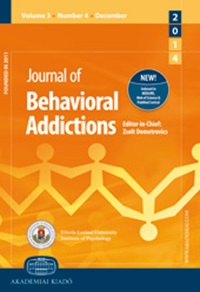跨研究的渴求预测:关于使用数据驱动方法时的概念和方法论考虑因素的评论。
IF 6.2
1区 医学
Q1 PSYCHIATRY
Journal of Behavioral Addictions
Pub Date : 2024-10-01
Print Date: 2024-10-04
DOI:10.1556/2006.2024.00050
引用次数: 0
摘要
渴求是药物使用障碍和成瘾行为障碍的一个核心特征。已有大量研究对渴求的发展和处理过程中涉及的神经机制进行了调查。最近,基于连接体的预测建模(一种数据驱动的方法)被用于四项研究,旨在预测与药物使用、成瘾行为和食物有关的渴求。这些研究在方法、样本和渴求概念上都有所不同。在这篇评论中,我们旨在通过考虑各项研究的概念和方法特点,对各项研究的结果进行比较、对比和整合。我们就各项研究中功能连接与渴求之间的关系推导出一个理论模型。本文章由计算机程序翻译,如有差异,请以英文原文为准。
Prediction of craving across studies: A commentary on conceptual and methodological considerations when using data-driven methods.
Craving is a central feature of substance use disorders and disorders due to addictive behaviors. Considerable research has investigated neural mechanisms involved in the development and processing of craving. Recently, connectome-based predictive modeling, a data-driven method, has been used in four studies aiming to predict craving related to substance use, addictive behaviors, and food. Studies differed in methods, samples, and conceptualizations of craving. Within the commentary we aim to compare, contrast and consolidate findings across studies by considering conceptual and methodological features of the studies. We derive a theoretical model on the functional connectivity-craving relationships across studies.
求助全文
通过发布文献求助,成功后即可免费获取论文全文。
去求助
来源期刊

Journal of Behavioral Addictions
PSYCHIATRY-
CiteScore
12.30
自引率
7.70%
发文量
91
审稿时长
20 weeks
期刊介绍:
The aim of Journal of Behavioral Addictions is to create a forum for the scientific information exchange with regard to behavioral addictions. The journal is a broad focused interdisciplinary one that publishes manuscripts on different approaches of non-substance addictions, research reports focusing on the addictive patterns of various behaviors, especially disorders of the impulsive-compulsive spectrum, and also publishes reviews in these topics. Coverage ranges from genetic and neurobiological research through psychological and clinical psychiatric approaches to epidemiological, sociological and anthropological aspects.
 求助内容:
求助内容: 应助结果提醒方式:
应助结果提醒方式:


